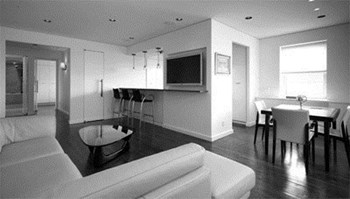
Starting a major renovation can be tough when you're dealing with a single-family home, but doing the job on a condo or co-op involves many considerations that house dwellers never face. It's not just a question of what contractors and professionals you will choose for the job, but also a question of whether the co-op board will accept your plans for the rehabilitation project. How will the neighbors react to the noise created from the work? These and many other considerations can make the rehab process seem daunting from the start, particularly for those who've never attempted such a job before.
Communicating effectively with the architect, general contractor and the managing agent is not second nature for people who've never worked in construction, and knowing what to ask of whom may be as important as hiring the right people for the job. An owner or shareholder's gut rehab job brings a lot more people into the process than just the local building inspector, as would be the case in the suburbs. Depending upon the complexity of the rehab job, an architect, engineer, interior designer, general contractor and numerous subcontractors all may have a hand in the work.
Who You'll Need
You've got a great space, but it needs a complete makeover, and you don't know where to start. You know it will need to be gutted and completely renovated, but you've never worked with a contractor or architect before, and you're not sure how to choose such professionals. What to do? Ask around.
Ask your managing agent and/or board if they would recommend any architect and contractor to do the job. Ask your neighbors if anyone in the building has had their space renovated recently, and if they have, who they would recommend for such a job.
A common mistake among novice rehabbers is starting the work without getting proper approval, industry professionals say. Another common mistake is hiring unqualified people for the work.
"Individuals will use people who are unlicensed, or they'll rely on the contractor, but not an engineer or architect," says Abbey Goldstein, who represents co-ops and condos as an attorney for the Manhattan-based law firm of Goldstein & Greenlaw.
Pick reputable contractors and professionals for the job, recommends Michael DiFonzo, owner of Central Construction Management, based in Long Island City. Do this by seeking referrals for such workers, getting letters of recommendation from those who might work on the rehab job, or even visiting places where the professional has done similar work before.
Some more expensive rehab jobs will also require an interior designer, who will help the owner pick out furnishings and decorate the space. Choosing such a professional is generally a matter of taste of the shareholder/condo owner, says Vincent Ribortone of Legacy Developers in Manhattan. "The interior designer works with the owner. So the architect doesn't necessarily need to hire the interior designer," he says.
Some initial things to do in starting the process of any remodeling endeavor, says Keith Steier, president of Brooklyn-based Knockout Renovation, might be researching the project. "Cutting out pictures of styles and finishes you like from magazines and creating a folder that a good designer will be able to incorporate into the design," are excellent ways to begin," he says.
Other rehab projects will need an architect's touch to design the particulars of the space, and some jobs might need the skills of a plasterer. A good general contractor should have working relationships with reputable professionals such as these, according to DiFonzo. Also, always make sure that you verify the insurance information for the contractor you choose for the job. Professionals can be chosen through referrals or looking at sources like The Cooperator's Official Directory of Co-op & Condo Services, The Franklin Report, and other guides, says Steier. Also talk to neighbors, the manager or the super to get professional advice.
Reputable contractors will know they must follow the guidelines for rehabs that are prescribed by the building management. The first step in that process is approval of plans for the rehab project.
Get Approval First
Before you allow a contractor to begin to work on your place, make sure that you have an architect draft plans for the work, and make sure the co-op board approves those plans. Starting the project without plans could set you on a collision course with the board, says Peter J. Burgess, owner of Brooklyn-based Peter J. Burgess Management Corp., which manages 21 Brooklyn properties.
In many cases, plans for a gut rehab will need to be provided to the building's managing agent.
"A complete set of plans has got to be delivered to us and our architect would review the plans at the owner's expense. Nine times out of ten, the architect comes back with questions," Burgess says, noting that plans are usually tweaked by the board or architect, but not rejected. "It's very rare that [a rehab plan] is forbidden outright."
On occasion, a rehab plan will be rejected. In such a case, the shareholder would have the option of talking to an attorney, who would determine what level of approval is necessary for the rehab plan to be accepted. Or the lawyer might ask for the specific reasons why the plan was denied, or for a meeting with the board, says Goldstein.
"You want to change the board's mind. Or you could go ahead and do the alteration [without approval] but you'd be taking a big risk," Goldstein says. "You could seek a declaratory judgment in state court, but the board has wide discretion in the decisions it makes. It is very difficult for an individual shareholder to overturn a decision of the board."
Usually, though, a shareholder needn't worry about running into such an obstacle, if he or she follows the rules of the rehab process.
Talk to Your Neighbors
One of the courtesy rules of that process is keeping your neighbors informed of the work that you plan to do. Some neighbors aren't going to be happy to hear about your good fortune and plans for your place, but they are likely to be more understanding if they know ahead of schedule that work will be going on in the space above or to the side of theirs. While most buildings have a 90-day limit on rehab projects, those days can drag for a neighbor who has to listen to incessant demolition work or nails being hammered day after day.
Enid Hamelin, director of advertising and public relations for Manhattan-based Lawrence Properties, has personally done two gut rehabs for places she's lived in. She says it's best to keep the noise level of the work being done as low as possible. Being mindful of the effect the work will have on the neighbors is important, she said, adding that she kept her neighbors informed.
"I sent a note to everyone telling them all I was moving in, and I sent them all a plant," Hamelin says. "And I also got everyone's approval before things [such as certain utilities] were turned off."
According to DiFonzo, having the rehab work completed in the allowable timeframe is a first step in keeping the neighbors happy.
"And you also should use the proper entrance when doing the work," DiFonzo continues. "Give your neighbors a schedule of the job. Before a noisy day, let them know."
Informing your neighbors before the project will help to keep them from complaining when they hear work being done. It will also make them feel that you've considered them. And if things go awry on the project and damage to a neighbor's space happens as a result of the work in your condo, your neighbors will know where to complain first.
"The contractor or project manager should confer with the resident manager or superintendent prior to starting work to find out things like elevator access days and hours, how long in advance a plumbing shutdown needs to be scheduled, working hours and public area protection requirements so that no one is surprised when the project starts. During the project most of the contractor's communication is with the apartment owner and the building staff," explains Steier.
Be Complete
Some people start a rehab job and think that they can save some of the old parts of the condo, hoping to save money in the process. Professionals argue against such a course.
"It's better to go in and start fresh, rather than working with old stuff, which will kill your time frame," says DiFonzo.
Part of the beauty of a gut rehab is the ability of the owner to completely refurbish the space. Many owners take full advantage and replace bathrooms and kitchens, which some in the industry advise they do.
Hamelin says gut rehab projects allow the owner to replace everything in the condo. "We recommend that people replace the pipes if they're opening up the walls anyway," she says. "Make sure your plans are tight and that you're happy with them," she adds.
An over-eager rehabber has the potential to create obstacles with the co-op board. While renovating kitchens and bathrooms can sometimes be tricky, but moving bathrooms and plumbing, as well as combining rooms are even more complicated. Removing walls and combining rooms could affect the structural integrity of the building. "The occupancy might need to be changed if you're combining apartments," says Burgess.
Finally, to ensure a successful, no-hassle rehab job, make sure you stay informed during the entire process. It's not enough just to have an architect draw up plans that are submitted and approved, Goldstein says. "Have an engineer monitor what's going on and make site visits, to ensure that the work is done properly."
Jonathan Barnes is a freelance writer living in Pittsburgh and a frequent contributor to The Cooperator.






Leave a Comment